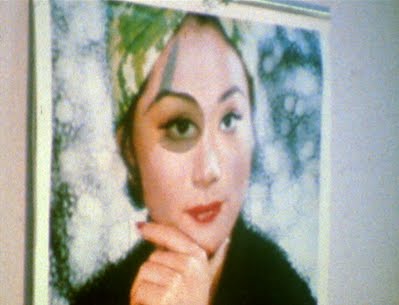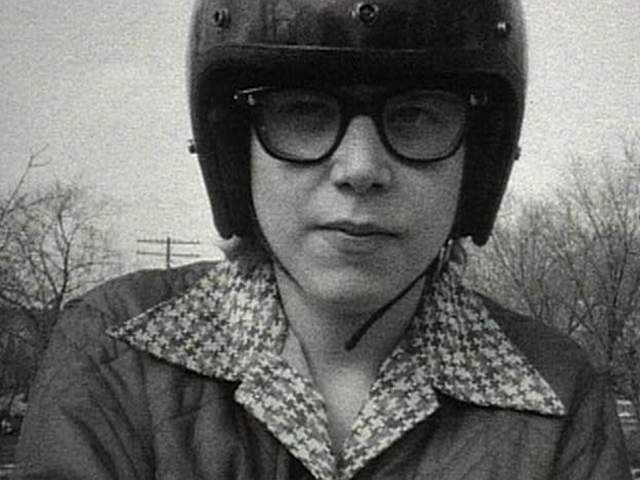Part of Summer 2010
In celebration of over three hundred screenings since Fall 1989, Pleasure Dome has asked two of Toronto’s most admired curators to gaze deeply into the archives and curate a two-part program of past works that still resonate from the darkened cinema.
Program 1: Association Games
“An anniversary is an occasion to take stock. Each film in this program is based around some type of inventory or enumeration. Rather than a strict taxonomy, each is a wayward list. While avowing a penchant for the ordering system, each is prepared to make certain exceptions to allow for whimsy. The films are grammatical but funny. The order of their appearance is as follows: a very rare print of Marcel Broodthaer’s A Voyage on the North Sea, uncorked for this special anniversary celebration; a plate of visual puns by John Smith; a California field mix by Robert Nelson; an I Ching surprise by Andrea Callard; and, for desert, a regional delicacy by Joyce Weiland.” SRS
Works:
A Voyage on the North Sea, Marcel Broodthaer, 1974, 16mm, silent, 5 min.
Associations, John Smith, 1975, 16mm on video, 7 min.
Bleu Shut, Robert Nelson, 1970, 16mm, 30 min.
11 thru 12, Andrea Callard, 1977, 16mm, 11 min.
Sailboat, Joyce Wieland, 1967, 16mm, 3 min.
Intermission
Program 2: Bodies Not at Home
“I think of Pleasure Dome over its twenty-year history and I think of the word ‘home.’ Pleasure Dome may indeed have a primary location, but in fact Pleasure Dome inhabits multiple homes. All of these homes are situated deliriously in between foundations and their materials — they are precarious and proud. This is a program in which bodies are not at home even when those bodies are homebound. There are too many loose cables, too many uncontrollable viruses, and too many colour palettes that cannot help exploding. These are films and videos for which the frames are barely adequate.” AJP
Works:
Shelter, Roberto Ariganello 2001, 16mm on video, 8 min.
Double, Riccardo Iacona 2003, video, 2:00 min.
Aberrant Motion # 1, Cathy Sisler, 1993, video 10:42
My Personal Virus, Steve Reinke 1994, video, 1:36 min.
What’s On?, Martha Colburn 1997, video, 1:43 min.
German Song, Sadie Benning 1995, video, 5:49
Dangerous When Wet, Diane Bonder 1992, video, 5:00 min.
When I Was a Monster, Anne McGuire 1996, video, 5:25 min.
Knocturne, George Kuchar 1968, 16mm, 10 min.
Andrew James Paterson is a media artist, writer, performance artist and musician based in Toronto. He has also engaged in film and video programming on select occasions.
Sarah Robayo Sheridan is Director of Exhibitions and Publications at Mercer Union and a curator for Scotiabank Nuit Blanche 2010. She holds an MA in Curatorial Practice from the California College of the Arts.
Programme Notes:
Bodies Not At Home — Pleasure Dome Archival Programme
An Essay by Andrew James Paterson
Well, Pleasure Dome is now twenty, and by this point of life most former teenagers have at least contemplated leaving home. But then, Pleasure Dome has always problematized “home”. I mean, they have one and then they don’t. Pleasure Dome doesn’t mind having a roof over its heads, but the organization is wary of restricting itself to any consistent roof. Keep those overheads low, and thus keep those standards high.
So I have responded to Pleasure Dome’s generous invitation to assemble or “curate” a programme for their twentieth birthday by thinking about “home“. As in, one can be simultaneously home and then not home. The home can indeed be a sanctuary but also a prison. The home may or may not have anything to do with family, or community, or any other of those words that can seem both comforting and confining. Home can be shelter, refuge, madness, and so many other definitions. It can be inside or outside and simultaneously familiar and very strange indeed. Home can of course be an alternative location to what the census-takers consider to be one’s residence. It can and should refer to where one is “at home”, whether alone or in a group or whatever.
An antonym of “home” is of course “homeless”. During prime tourist-influx events (including the upcoming G-20 summit and the annual Toronto International Film Festival among others), it is imperative that the mega-city appear spic and span and therefore visible homelessness is not tolerated. Mess is not tolerated by either politicians or the stars this despite their own chronic messiness. But Pleasure Dome has always tolerated mess. Images that refuse to stabilize, images that must be immediately contradicted by a sequential or parallel image, viruses that spread delirium instead of disease these are all embedded in Pleasure Dome’s mandate. Absolute abstractionism and hilarious (mis)representation can co-exist within the same work and in the same programmes. These bodies can take it, they can hold it. They can spin with dignity and drive while being invalid.
I search and Google through Pleasure Dome’s twenty years of exhibition and I see bodies appearing, disappearing, and reconfiguring. Bodies have home bases but refresh themselves by going AWOL from those bases or foundations. I comb through the titles that I have personally selected for this exhibition or programme and I see some wild oscillations between comfort and danger zones. I observe contagious bodies viruses capable of both infecting and transforming. I see bodies which are supposed to be recuperating but are instead engaged with forms of psychic driving beyond the comprehension of shrinks and other control-agents. I see bodies that can’t stop spinning.
In much of Pleasure Dome’s programming and their archives bodies and performativity are displaced into the actions of editing and also the processes of realising inventories. Bodies are not always present in the frames. However, throughout this programme which is titled Bodies Not at Home the alternately hesitant and assertive bodies tend to be visible. Perhaps this is an echo of my essay for the Pleasure Dome/YYZ anthology LUX, published in 2000 in tandem with the tenth anniversary. Perhaps this is a residue of my own performative tendencies which never quite disappear despite intentional displacements. Perhaps this emphasis on bodily presence has to do with my own observations regarding bodies throughout experimental film and video, which of course must remain distinct from Hollywood and the theatre and the whatever. After twenty years, I’m not sure that I myself really know. But that itself can comprise a pleasure zone, deliriously akin to parallel nomadism and shelter.
Homes are also, of course, institutions. Pleasure Dome have played a clever cat-and- mouse game with institutionalism over their duration. After twenty years, even the most anarchist Fluxist Situationist shit-disturber will have become an institution. But Pleasure Dome is lean and even mean. Institutions can be a good thing reliable presence has its merits. Institutions of course often also imply impenetrable bureaucracy and stupid rules and Official Redundancy. However, Pleasure Dome has, I strongly believe, managed to avoid its own obsolescence by being at home and never really at home. A relatively consistent group of hosts will be the persons answering the doorbell, but the guests tend to be in flux and therefore the house is able to remain pleasantly and naggingly undefined.
This programme also salutes twenty years of Pleasure Dome’s collaboration with Martin Heath’s fabulous anti-institution institution CineCycle, a home which is not a home.” AJP
————————————————————————————————————————————————
“An anniversary is an occasion to take stock. Accordingly, each film in this programme performs some type of inventory or enumeration. Rather than a strict taxonomy, each is a wayward list. For the record, none of the films have previously screened at Pleasure Dome. So in the prescription to curate from the archives, I got a little waylaid in a chain of association. I hope that this slightly dyslexic impulse makes an apt tribute to Pleasure Dome’s own makeshift spirit.
The screening opens with an orphaned part of Marcel Broodthaers hybrid book-film A Voyage on the North Sea. I call it orphaned because the book and the film were intended to be distributed together. I haven’t brought you the book, but I unearthed the film. As you shuffle through the pages of the film, know that this projection is a dislocation from a larger whole. Describing his uneasy relationship to film, Broodthaers offers: “I am not a filmmaker. For me, film is simply an extension of language. I began with poetry, moved on the three-dimensional works, finally to film, which combines several artistic elements. That is, writing (poetry), object (something three-dimension), and image (film). The great difficulty lies, of course, in finding a harmony among these three elements.”
The interplay between word, image and object is key to each of the works selected. John Smith, who I was first introduced to thanks to a Pleasure Dome screening, exemplifies his typical wit through a codex of visual puns in Associations. Smith’s parade of images create are a learning system, a zanny alphabet of objects and linguistic false cousins.
Robert Nelson’s Bleu Shut likewise relies on word play. As Scott MacDonald notes: “Even when we know the game is an illusion, the experience of Bleu Shut is entirely a pleasure: the ‘game’ is fun, the Nelson/Wiley debates, infectiously funny; and Nelson’s choice of imagery, quirky and amusing.” Nelson, a San Francisco native, was an important post-beat American painter who moved into filmmaking in the mid-60s. While this was a popular underground pick in the 1970s, this treasure went missing only to be resuscitated in recent years through the efforts of Mark Toscano, archivist at the Academy film archives.
11 thru 12 was a recent discovery for me. Screened in the context of a circulating program of “no-wave” films made by artists associated with the New York scene of the late 70s, Callard’s 11 thru 12 stood out as a very singular voice. Working along the principle of the I Ching, the “book of changes” that inspired John Cage’s notion of chance operations, Callard weaves together a dreamy set of associations. They add together to form a subjective and intuitive diary of the artist’s experience as a California transplant to New York in the 1970s. The film is tender and charmingly free.
Finally, Joyce Wieland’s Sailboat neatly closes off the program’s subplot of nautical elements. In this simple film, Wieland transposing text against object so that the word “sailboat” is stamped over the photographic image of the same. Robert Cowan comments; “Sailboat has the simplicity of a child’s drawing. A toy-like image of a sailboat sails, without interruption on the water, to the sound of roaring waves, which seem to underline the image to the point of exaggeration, somewhat in the way a child might draw a picture of water and write word-sounds on it to make it as emphatic as possible.”
The rules of the association game played in all five of the films are perfectly identified in John Smith’s voiceover: 1. the player must understand the stimulus; 2. he must operate on the meaning of the stimulus; 3. he must produce a response.” SRS

